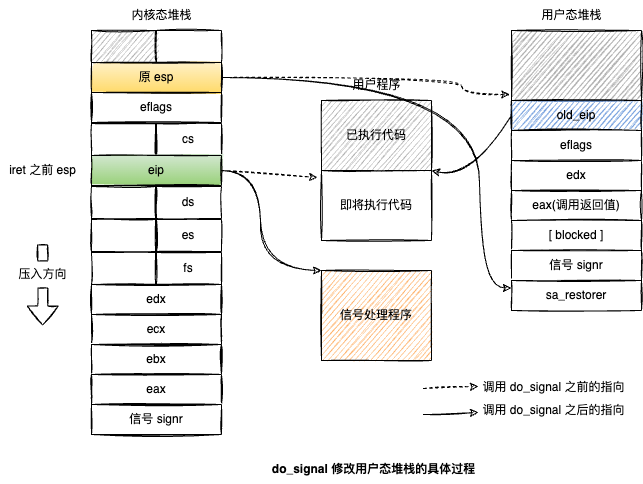First, the example
#include <stdio.h>
#include <unistd.h>
#include <signal.h>
#include <errno.h>
static void sig_usr(int signum) {
if (signum == SIGUSR1) {
printf("SIGUSR1 received\n");
} else if (signum == SIGUSR2) {
printf("SIGUSR2 received\n");
} else {
printf("signal %d received\n", signum);
}
}
int main(void) {
char buf[512];
int n;
struct sigaction sa_usr;
sa_usr.sa_flags = 0;
sa_usr.sa_handler = sig_usr;
sigaction(SIGUSR1, &sa_usr, NULL);
sigaction(SIGUSR2, &sa_usr, NULL);
printf("My PID is %d\n", getpid());
while(1) {
if (n = read(STDIN_FILENO, buf, 511) == -1) {
if (errno == EINTR) {
printf("read is interrupted by signal\n");
}
} else {
buf[n] = '\0';
printf("%d bytes read: %s\n", n, buf);
}
}
return 0;
}scatter read
gatter write
signal 通常使用一个 32 位无符号整数( man 7 signal), 使用单 bit 表示,因此可以表示 32 个信号。signal() sigaction() 功能类似,更改信号 handler。signal() 每次处理完需要重新设置。
但是 signal() 在已经进入自定义信号处理函数时,但是重新设置之前,可能系统又发生了信号,会丢失。sigaction 更可靠的原因是,在信号处理中,被捕捉的信号会被屏蔽,并且不用每次重新设置处理函数。
signal 中断当前进程进入内核原理在于 do_signal() 函数:
